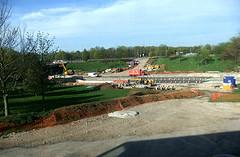 In the design of any product want to make it practical, technologically advanced and durable. This is achieved by correct selection and the material, and an increase in precision manufacturing. However, loaded with details, or working in argessivnyh media exposed their work with the action of the destructive forces of friction and chemical corrosion, and therefore the question arises and surface protection products. Among all the modern methods of chemical heat processing of steel products, such as cementing, nitrocarburizing, carbonitriding and gas nitriding in ovens most efficient and technologically advanced method is the ion-plasma nitriding. The essence of this the method is controlled modification of the crystal lattice of the workpiece in the surface layer by ion implantation.
In the design of any product want to make it practical, technologically advanced and durable. This is achieved by correct selection and the material, and an increase in precision manufacturing. However, loaded with details, or working in argessivnyh media exposed their work with the action of the destructive forces of friction and chemical corrosion, and therefore the question arises and surface protection products. Among all the modern methods of chemical heat processing of steel products, such as cementing, nitrocarburizing, carbonitriding and gas nitriding in ovens most efficient and technologically advanced method is the ion-plasma nitriding. The essence of this the method is controlled modification of the crystal lattice of the workpiece in the surface layer by ion implantation.
Ion implantation – is the introduction of a solid surface practically any ion, pre-overclocked to electromagnetic pole.Eti ions are introduced into the material to a depth of 0.01 to several tens of microns, creating a surface layer of a special strkuturnoe state. The thickness of modified layer depends on the ion energy, mass and mass of the target atoms. The ion energy can vary widely (depending on the material properties combined ion – target) 1 (keV) to several MeV (MeV). Besides the introduction of the ion in the target surface occurs without complying with the laws of classical thermodynamics, which determines the equilibrium processes such as diffusion. Office of the penetration depth ions in the surface layer by changing the ion beam energy and the number of ions entering the target per unit time (Fig. 1) Li-ion plasma nitriding (IPA) – a kind of physical-chemical treatment metal parts, tools and other equipment, allowing the product to saturate the surface layer of nitrogen in the nitrogen-hydrogen plasma at 500 0C.
The essence of the method of the IPA is that discharged to 200-300 Pa nitrogenous gaseous medium between the cathode, which are the workpieces, and the anode, which serves as the walls of the vacuum chamber is excited by the anomalous glow razryad.Imenno it generates reactive species ionization of molecules of the gas environment (ions and radicals). This provides a form on the surface of the workpiece of the nitrided layer consisting of a foreign – nitride zone and settling down beneath the diffusion zone. By changing the composition of the gas in the chamber, its pressure, working temperature and exposure time product in a cell, you can get layers of a given structure and phase composition, providing a strictly regulated properties of steels and alloys. Improving the properties of hardened surface provides the required combination of nitride and the diffusion layers, which seem to "grow" in the surface layer of core material. At the same characteristics and properties surface layer is completely determined by its chemical composition: the nitride layer is either the Y-phase (Fe4N), or E-phase (Fe2-3N). Layer with E-phase is a corrosion-resistant, and a layer of Y-phase of a durable and relatively malleable. In this case, depending on the purpose of processing, as a result of ion-plasma nitriding can get: a diffusion layer with a developed area of nitride, which provides protection against corrosion and friction running-in surfaces – for parts operating under friction, the diffusion layer without the nitride zone – for cutting and stamping tools and parts operating under conditions of alternating loads of wear at high pressures. Ion-nitriding improves plazmenennoe following product characteristics: wear resistance, fatigue endurance antizadirnye properties, heat resistance, corrosion resistance.